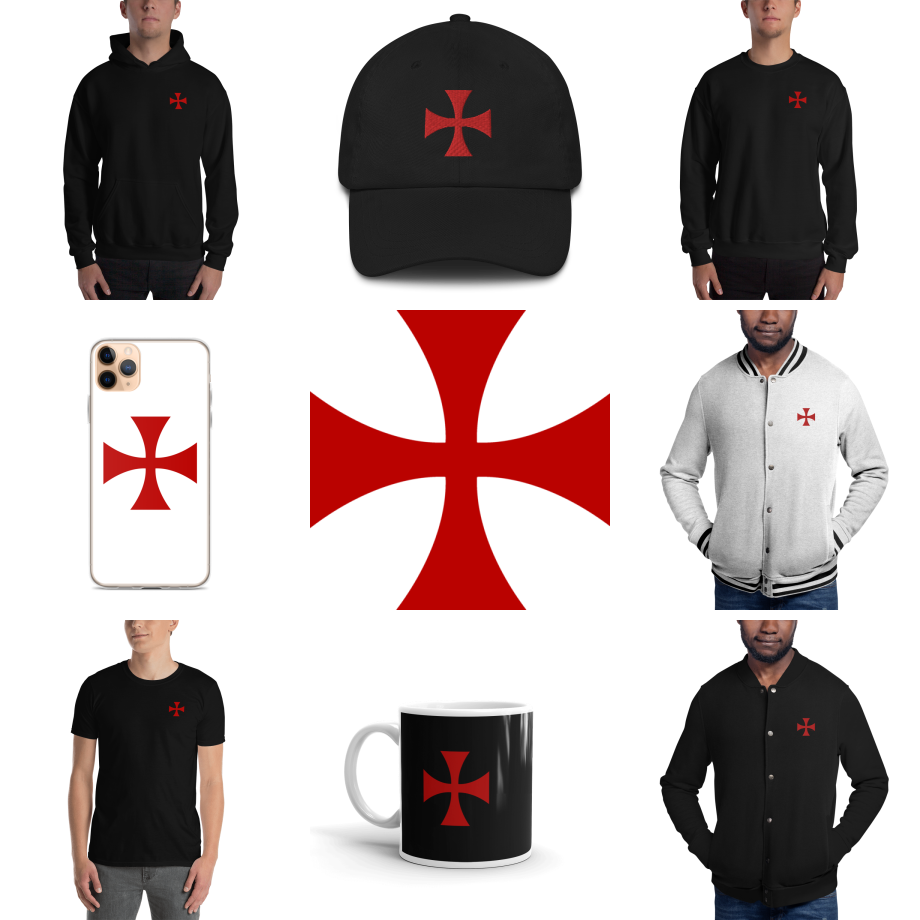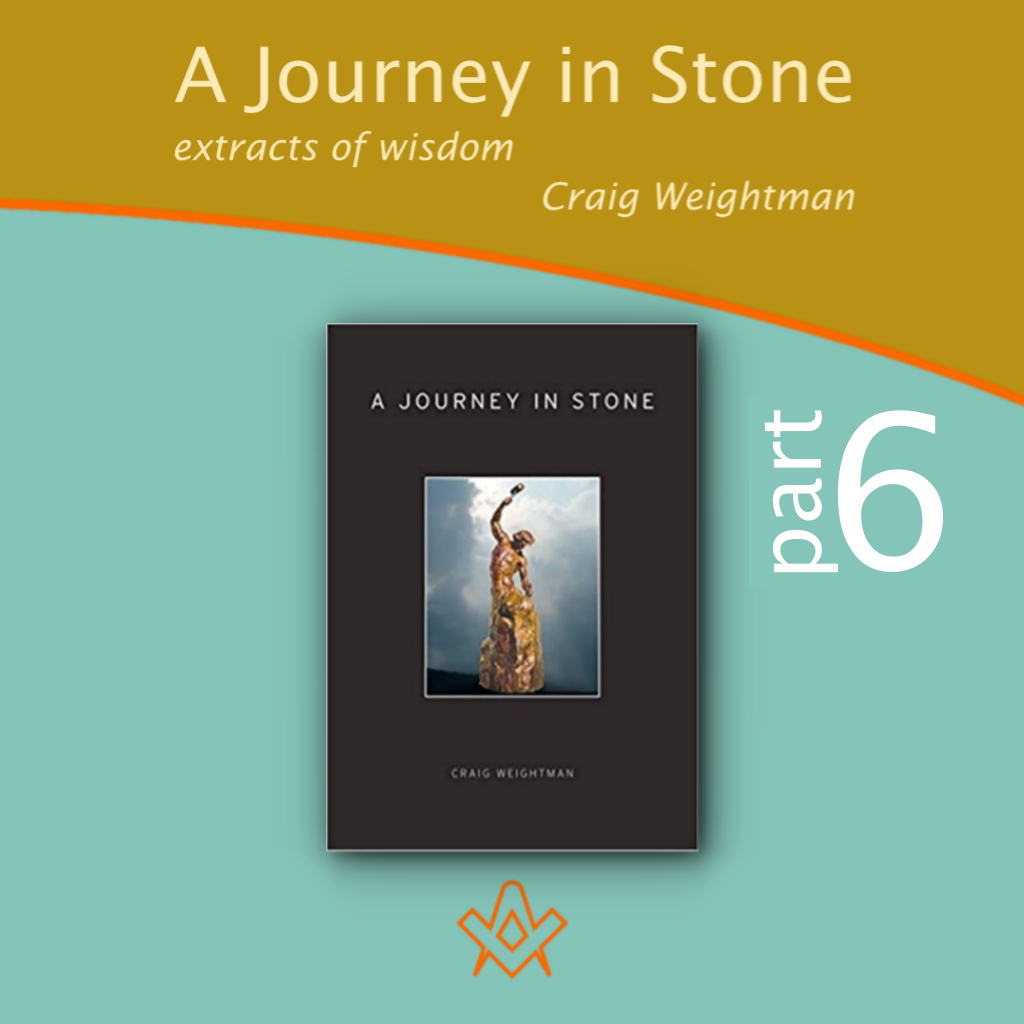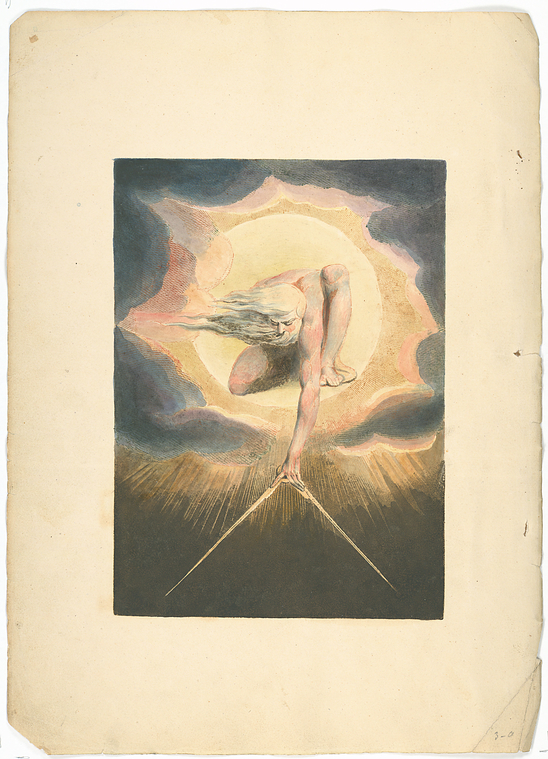For those who have enjoyed Craig Weightman’s thought-provoking and inspiring monthly features, this book collates his collective wisdom and philosophy, taking you on a fascinating ‘journey in stone’.
Over the next months, we will feature select extracts from ‘A Journey in Stone’ – if you enjoy these, please support Craig’s work by buying a copy.
“This book is the result of years of exploration by myself since I joined the Order of Freemasons in 2004. After following an identical story to the one expressed at the beginning of this preface, I found the process of initiation a truly transformative process.”
Craig Weightman.
A Journey in Stone
Extracted and abridged from A Journey in Stone: Chapter 5 – The Working Tools of the Third Degree
As the journey of Freemasonry progresses, it becomes clear that the Degrees seem to be representing the human individual and their journey through life.
The First Degree represents an individual’s entry into the society of Freemasonry. It is an initiation because it marks the beginning of a new phase in the new Freemason’s life, a point where the old rules of life are augmented by a new set of guidelines.
Putting it another way, initiation is meant to represent a kind of rebirth into a morally mindful life. The First Degree, then, can be seen to represent the birth of an individual into the world.
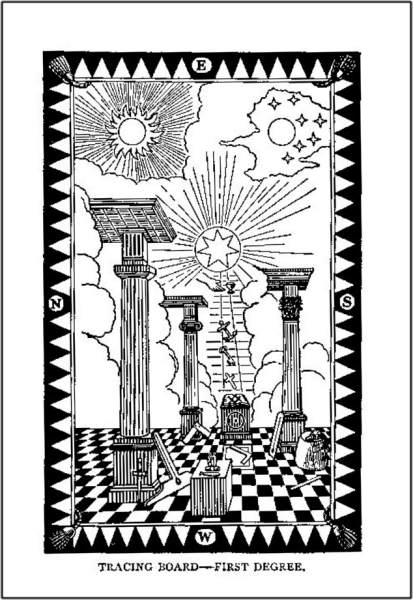
The lectures of the three degrees in craft masonry (complete), A. Lewis, 1874.
IMAGE LINKED: wikimedia Attribution 4.0 International (CC BY 4.0)
Following the First Degree comes the Second, which appears to represent the journey of the Masonic life.
One of the more beautiful symbols in Freemasonry appears in this Degree and takes the form of a winding staircase.
The particular winding staircase in Freemasonry is one that leads from the ground floor of King Solomon’s Temple to the middle chamber of that temple. We will be discussing this building in more detail in a later chapter.
The Freemason symbolically ascends this staircase to arrive at the middle chamber. In other words, as a Freemason improves themselves morally, represented by the ascending journey, they are also slowly uncovering their true inner selves, represented by the destination of the middle chamber.
Eventually, after a considerable time of self-study, the Freemason will arrive at a realisation of themselves at their very core.
The life of the Mason is one of mindful self-discovery and moral improvement. Following the birth of the Entered Apprentice in the First Degree, then, comes the representation of the path of life.
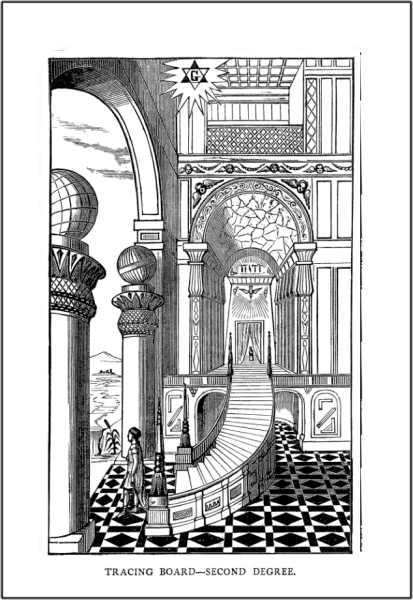
The lectures of the three degrees in craft masonry (complete), A. Lewis, 1874.
IMAGE LINKED: wikimedia Attribution 4.0 International (CC BY 4.0)
Before moving to the final Degree, we should deal with why this staircase is a winding one. When a person ascends a winding staircase, they cannot easily see around the corner.
In addition, they cannot easily see round the corner behind them. The only thing visible to them is the step they are standing on and perhaps the steps immediately in front and behind.
This is intended to represent the fact that, as we move through life, we cannot know what the future holds, and we cannot directly perceive our past but must rely on our memories. The only relevant moment is now.
As we move, we inhabit one moment at a time, never knowing truly what the next one will hold. Therefore, the Freemason is reminded to be completely mindful of the present and to keep moving forward.
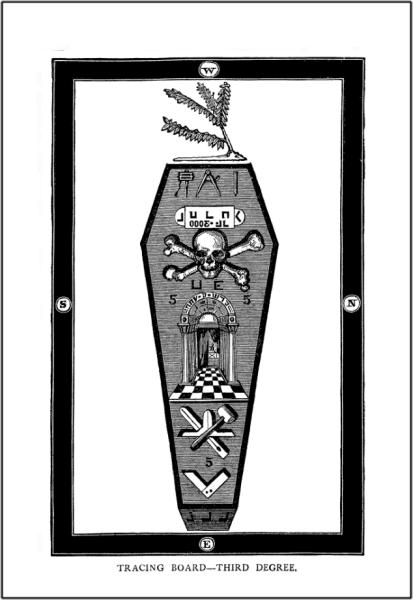
The lectures of the three degrees in craft masonry (complete), A. Lewis, 1874.
IMAGE LINKED: wikimedia Attribution 4.0 International (CC BY 4.0)
The Third Degree in Freemasonry has a more sombre tone and explores the inevitable destiny of each human being.
However, this is merely used as a context for living life morally. If human life is limited, then it is important to use the time we have to impact upon the world as much as we can in a positive way.
Following the six tools of the previous two Degrees, three of direct self-crafting and three of guidance and measurement, the three working tools of the Third Degree have a wider perspective.
The tools are the skirret, the pencil, and the compasses. Where the previous stonemasons’ tools are used to work on the individual components of the intended structure, the working-tools of the Third Degree are directed towards the building of the structure as a whole, within the context of the ground on which it is to be built.
Symbolically, these tools put everything that has gone before into context.
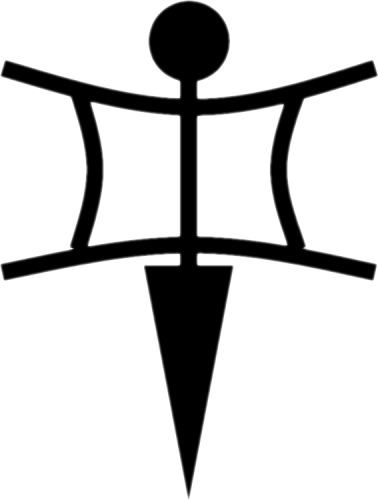
The Skirret
The first of these tools, the skirret, is a pin or post that has a rotating mechanism on top of it that allows a line to be unwound.
In the use of actual stonework and the building of structures, this tool is used to help mark out the ground according to the architectural plan, so that the building blocks can be placed correctly and to ensure the alignment of the building as a whole.
Clearly, this tool creates a relationship between the drawn plan on which the building was first designed and the actual ground on which the real building is to be built. To interpret this tool symbolically, then, we must understand the symbolism of the building and the architectural plans.
Firstly, we should understand that the building represents society as a whole, with each building block representing an individual within society.
Once this is understood, it naturally follows that the architectural plans represent a scheme to help that society to come together in an orderly structure.
Therefore, the skirret is the tool that communicates that scheme to the actual individuals within society so that they understand their place within that scheme.
Where, then does this scheme come from? Freemasonry suggests that it can be found in the Volume of the Sacred Law.
The Volume of the Sacred Law itself, in Freemasonry, is a symbol to represent the central scripture in a Freemason’s particular faith.
It is understood that the harmonious structure of society has its prototype laid down in the spiritual books of the world.
The implication is that if the Freemason studies his particular volume of the sacred law, then he will understand his role in bringing society into a harmonious structural whole.
In other words, in the context of the perfect ashlar, the Mason can understand where his ashlar is to go in the construction of the building.
Essentially, the message of the skirret is the finding of one’s purpose for the benefit of society. As in the placement of building blocks in a building, it is very important to understand where one can be of best service within society.
All buildings stand because of the mutual interdependency of each of the component pieces of stonework. Each block is designed to hold particular weights and to direct particular forces. Similarly, individuals within society all have something they can offer and, through expressing this in their relationships with others, society is formed.
It is for this reason that Freemasonry is about the understanding of the Self. It is not until we understand ourselves that we can truly render ourselves extensively serviceable to mankind.
Once we have understood how we can be of service, we will naturally gravitate towards the communities and areas of society we can serve most effectively.
The symbolism of the skirret doesn’t just help the Freemason to find how they can be of best service to society, however. This working-tool also has a more moral import.
The source of the grand plan for a harmonious society is seen to be scripture, and this means that morality is implied. The closest thing to morality on a societal level is the law.
It can be seen that many of society’s laws have their origin at least in part in religion. In the Judaeo- Christian west, the basis of many laws can be seen to be the Ten Commandments.
Therefore, if a Freemason follows the law of the land, then he is perhaps naturally following the moral dictates laid down in scripture.
In addition, religious scripture gives guidance on how best to behave on a more interpersonal level.
For instance, Christian scripture offers guidance on forgiveness, the treatment of guests and the easing of toxic relationships between enemies.
The moral implication of the skirret is that, if everyone in society behaves morally, then we will obviously end up with an entirely moral and harmonious society.
Regardless of how the individual Freemason regards the source of morality, the ultimate lesson of the skirret is to live the most moral and helpful life one can, i.e., to serve one’s fellow man so that those around us can benefit.
As the individuals act in such a way, certain positive behaviours will tend to be communicated to others, who will behave similarly.
By having an understanding of morality and by ensuring that they endeavour to behave in such a way as to be true to these moral standards, the general moral structure of humanity slowly improves.
Similarly, by searching within and understanding themselves sufficiently the Freemason can find how they can be of the greatest service to mankind.
In this way, human society can move forward under the momentum of the individuals who comprise that society.
If everyone in society were to strive to act morally, for the benefit of others, and to improve themselves with the aim of becoming practically beneficial to others, then society would be a wonderful place indeed.

The Pencil
The second working-tool of the Third Degree is the pencil. This simple implement – in the context of stonework – is used by the architect of a building to draw up the plan of the intended structure.
However, in the context of Freemasonry the pencil is meant to represent how our thoughts, words and actions are recorded by the Great Architect of the Universe.
Once again, this states that behaviour is watched by the divine figure as represented in one’s particular faith.
The implication is that the divine creator is the one who is likely to reward or punish us, and that this is the character who is recording our behaviour.
Therefore, we are reminded that we should always act as if we are being watched.
Generally speaking, people will never act negatively if there is someone watching, so being mindful of being watched by something or someone greater than ourselves is more likely to keep us in line wherever we are, alone or not.
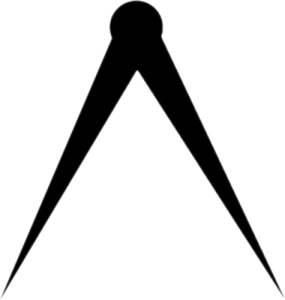
The Compasses
The final working-tool in the Third Degree is the compasses. In stonework, compasses are used to measure relative proportions on building- plans, and they help in assisting the rendering of circles during the process of designing the structure.
However, in Freemasonry, as may be expected, the compasses have a moral meaning. The moral lesson in this instance is that we essentially reap what we sow.
The way Freemasonry puts it, is that the Great Architect of the Universe will punish or reward as the Mason obeys or disregards his divine commands.
Europe – a prophecy”, William Blake, 1794
IMAGE LINKED: The New York Public Library Digital Collections Attribution 4.0 International (CC BY 4.0)
Living any life of immorality and selfishness, even if it is somehow lived entirely guilt-free, seems to only eventually result in an unfulfilling and unhappy life.
It would seem that nature does indeed punish or reward as we act selfishly or selflessly. This, then, would seem to nicely resolve the lesson of the compasses.
The source of all things does indeed seem to have ensured that punishment or reward is written into the very workings of the cosmos, and that they become apparent through the logic of human existence itself.
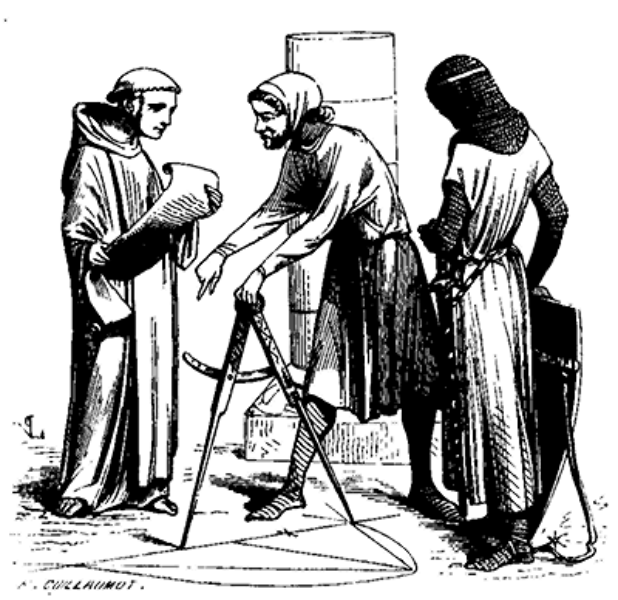
Dictionary of French Architecture from 11th to 16th Century (1856) by Eugène Viollet-le-Duc (1814-1879)
IMAGE LINKED: wikimedia Attribution 4.0 International (CC BY 4.0)
As well as teaching a moral lesson, something else is alluded to by the compasses. It is well known that compasses are directly related to the construction of circles.
However, what may not be so widely known is the fact that the circle is directly related to matters of spirituality in many cultures around the world.
This is because the heavens themselves appear to be replete with circles. The sun appears to be a circle, as does the moon.
The sun rises in the east and sets in the west, apparently completing a circular path each day. The years are constructed from a repeating cycle of four seasons. Everywhere human beings can look in the heavens, circles are to be found.
The compasses, being the tool of the traditional stonemason most closely related to the circle, are clearly the ideal symbol to represent the cycle of the universe processing around the circle.
However, when combined with the square, in other words when using the right angle, the source of the circle, the centre, may be discovered.
This view of the compasses working alongside the square to reveal the deeper underlying truth of the cosmos directly aligns with Freemasonry as an expression of the ancient idea of initiation.
Remembering that the purpose of initiation is to reveal inner truths about the Self and the universe, and to unveil their interconnectedness the Freemason uses the square and compasses as they journey on their path of esoteric knowledge.
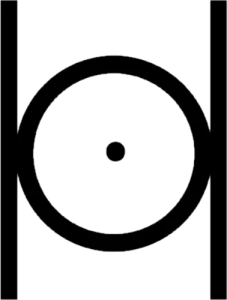
Once the centre of the circle, as a symbol for the source of all things, is revealed to the Freemason, they will then be able to see the greater importance of the compasses for, if one were to place one point of the compasses onto the centre, one could describe a circle with the other point.
This clearly points to the process of the creation of all things. Therefore, as the Freemason progresses on their journey, they come to understand the relationship between the origin and everything else in the cosmos.
To show that this knowledge is developing, at the beginning of the journey, in the combined symbol of the square and compasses, the points of the compasses are hidden by the square. However, by the time the Freemason arrives at the Third Degree, both compass points are revealed.
This shows that the true relationship between existence and the transcendent source is buried beneath the material of the universe, as represented by the square, yet can be revealed by studious inquiry.
Looking at the square and compasses combination in yet another way, we can see that the human morality represented by the square has been placed under direct influence of a more stable morality derived from the transcendent source of all things.
This makes sense when seen in the context of the other tools in the Third Degree. Both the pencil and the skirret seem to be directing the Freemason to turn their attention to understanding divine morality by understanding how it is laid down in their own expression of the Volume of the Sacred Law.
As a transcendent law is revealed through spiritual discipline and study, the Freemason is better enabled to express this in their daily life and may allow their behaviour to change for the benefit of society. Hence, the symbolism of the spiritually related compasses overshadowing the square.
Still another yet related way that the compasses can be interpreted is the idea of keeping in due bounds with all mankind.
In this interpretation, the square represents the morality of the individual Mason while the overshadowing compasses represent the general morality and laws of mankind.
This interpretation helps to put to rest the idea that Freemasonry is a secret society that is in danger of following its own agenda; the Masonic ceremonies themselves imply that Freemasons are to keep themselves in due bounds with all humanity.
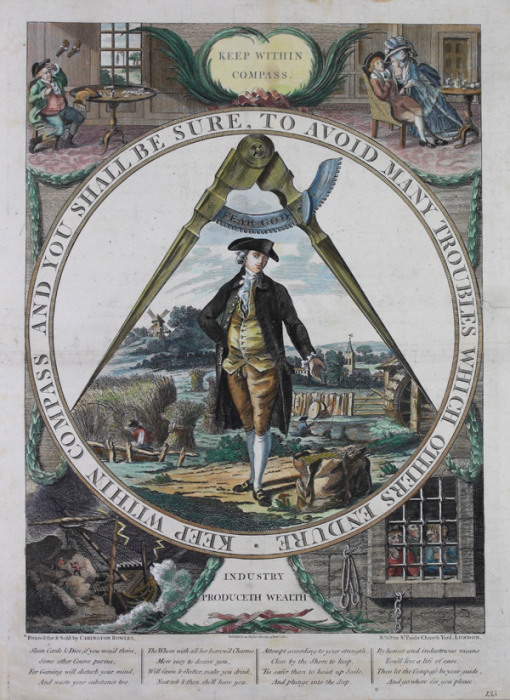
‘Keep within Compass’, after Robert Dighton, 1784. Publisher Carrington Bowles No. 69 St. Paul’s Church Yard,
IMAGE LINKED: wikimedia Attribution 4.0 International (CC BY 4.0)
As well as a tool to convey the lesson of morality, the compasses are clearly incredibly important on the journey of the Freemason and help them to uncover their relative place in the wider universe.
Looking back over all of the tools of the Third Degree, they are all about the overall plan of the building work in building terms.
Therefore, they symbolise the wider perspective of a Freemason’s place in the universe, once they have crafted themselves into a more serviceable state.
Effectively, the tools of the Third Degree create an overall context for the tools of the previous two Degrees.
As has been already mentioned, the crafting of the First Degree, aided by the guiding self-measurement of the tools of the Second Degree, are all in order to prepare the Freemason for service in the wider world. This mirrors the actual working of a stone.
The material is worked on and crafted, helped by the tools of measurement, in order to render the stone serviceable for the structure for which it is intended.
As the Freemason progresses through their Masonic life, they pay attention to all of the faculties intended for development through the contemplative Masonic life.
In the First Degree, the Freemason is taught how best to utilise the 24 hours they are given each day.
As they progress through their days they are encouraged to listen to the voice of conscience, which is a guiding light within, that will help point them in the right moral direction.
In order to be more serviceable, Freemasons are encouraged to educate themselves as much about the world in as many subjects as they can, and to educate themselves specifically about their own particular area of specialism in life, whatever it might be, so that they can offer the best service possible in their work.
In the Second Degree, the emphasis is on being mindful of where work still needs to be done.
Therefore, the Freemason is expected to constantly be aware of whether they are acting completely morally with other people and when they are not, to ensure they focus more on their conscience and education of how best to relate to others.
The Freemason is invited to be mindful of whether their actions are based on a sense of equality with others and, if not, to alter it through conscience and education.
Finally, for the Second Degree, the Freemason is encouraged to test whether their actions are always matched to the most upright of their intentions.
Ultimately, in the Third Degree, the Freemason is encouraged to seek out the best way to place themselves in society so that they can be of best use to mankind, and they are taught to ensure that the highest and most general moral rules dictate their behaviour.
Alongside all of this, the Freemason seeks to uncover the relationship between the source of all things and the emergent cosmos.
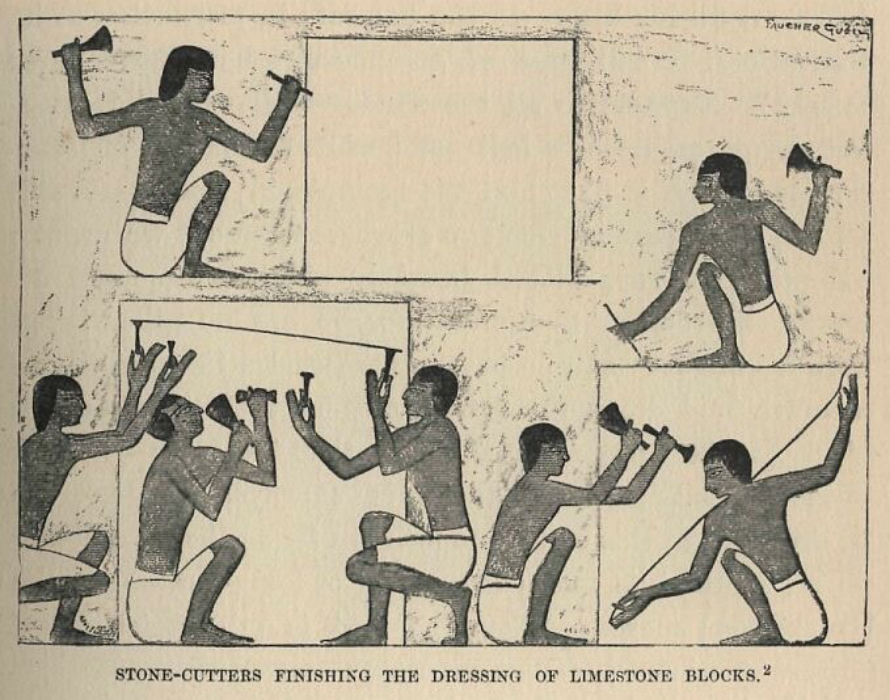
History Of Egypt, Chaldea, Syria, Babylonia, And Assyria Vol. 2, p.99. G. Maspero, 1903. Drawn by Faucher-Gudin, from Rosellini, Monumenti civili, pl. xlviii. 2.
IMAGE LINKED: wikimedia Attribution 4.0 International (CC BY 4.0)
The final product after the working-tools of Freemasonry have worked on the Mason is the smooth ashlar, and it is this symbol to which we turn in the next chapter.
Reproduced with permission from the publisher Lewis Masonic. All rights reserved.
Follow Craig on Twitter: @WeightmanCraig
Read about Craig’s work as a Senior lecturer in Games and Visual Effects, Staffordshire University
https://theconversation.com/profiles/craig-weightman-430199/articles
Video Presentation
Article by: Craig Weightman

Craig Weightman grew up in Hinckley, Leicestershire and was educated at the University of Leicester, gaining a degree in Psychology and Computer Science.
He was initiated into Freemasonry in 2003, and became master of his lodge in 2014.
Outside of his interests in Freemasonry, Craig is a lecturer in Computer Games Design and Computer Science at a college in Warwickshire. He also develops websites for businesses.
Craig is the author of 'A Journey in Stone'.
 A Journey in Stone – Extracts of Wisdom p.10 More extracts of wisdom from Craig Weightman's book 'A Journey in Stone' – in this final part in the serialisation, we discover the Transformative Symbolism of the Royal Arch – and the end of the journey. |
 A Journey in Stone – Extracts of Wisdom p.9 More extracts of wisdom from Craig Weightman's book 'A Journey in Stone' – this month, we explore the 'Illusion of the Self and the Truth of Interdependency' |
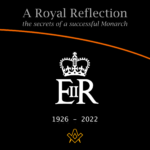 A Royal Reflection – the secrets of a successful Monarch On the death of Her Majesty Queen Elizabeth II, Craig Weightman, in a fitting tribute to an exemplar, recently departed, reflects on how the late Monarch's life demonstrated how we should all live every moment, as we serve others. A poignant reflection on a life that was resplendent in virtue, to the benefit of all, which is what Freemasonry attempts to teach us. |
 A Journey in Stone – Extracts of Wisdom p.8 More extracts of wisdom from Craig Weightman's book 'A Journey in Stone' – this month, we explore |
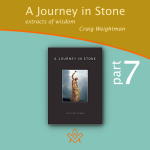 A Journey in Stone – Extracts of Wisdom p.7 More extracts of wisdom from Craig Weightman's book 'A Journey in Stone' – this month, we explore |
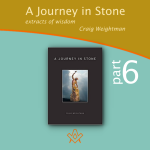 A Journey in Stone – Extracts of Wisdom p.6 More extracts of wisdom from Craig Weightman's book 'A Journey in Stone' – this month, we explore the Working Tools of the Third Degree. |
 A Journey in Stone – Extracts of Wisdom p.5 More extracts of wisdom from Craig Weightman's book 'A Journey in Stone' – this month, we explore the Working Tools of the Second Degree. |
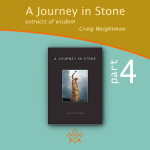 A Journey in Stone – Extracts of Wisdom p.4 The Working Tools of the First Degree – the twenty-four-inch gauge. This book collates masonic author and psychologist, Craig Weightman's collective wisdom and philosophy, taking you on a fascinating 'journey in stone'. |
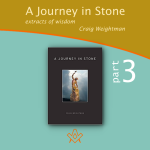 A Journey in Stone – Extracts of Wisdom p.3 This book collates masonic author and psychologist, Craig Weightman's collective wisdom and philosophy, taking you on a fascinating 'journey in stone'. |
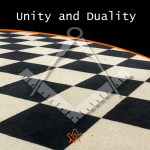 Craig continues his previous exploration into the 'hero's journey' through life's travails; this month we discover how within the stormy sea of battling opinion and confusion, there is an island called Freemasonry. |
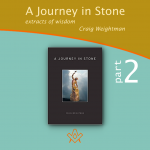 A Journey in Stone – Extracts of Wisdom p.2 This book collates masonic author and psychologist, Craig Weightman's collective wisdom and philosophy, taking you on a fascinating 'journey in stone'. |
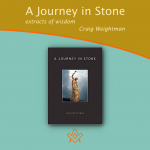 A Journey in Stone – Extracts of Wisdom p.1 For those who have enjoyed Craig Weightman's thought-provoking and inspiring monthly features, this book collates his collective wisdom and philosophy, taking you on a fascinating 'journey in stone'. |
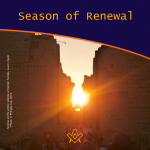 This spectacle takes place at the same time every year. Literally, the sun 'dies' for three days, then is reborn on the Christmas morning. |
 Coming to Terms with the Great War Within Ourselves Discover your 'shadow' - the black-and-white path to self-awareness - "A man who is possessed by his shadow is always standing in his own light and falling into his own traps...living below his own level." - Carl Jung |
 The Masonic Art of Being a Gentleman What defines the masonic art of being a gentleman; a chivalrous, courteous, or honourable man? |
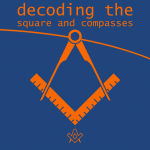 Decoding the Square and Compasses The square and compasses is the most famous symbol with which Freemasonry is identified. However, this is not just a logo that helps the organisation to stand out from the rest. |
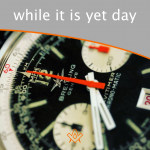 Each moment is a gift that you can make the most of. We can all do more; many of us do not live our lives to the full. |
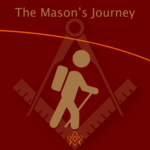 The hero’s journey can also be seen in the Masonic system; a candidate first considers embarking on the Masonic journey but wonders whether it is really for him |
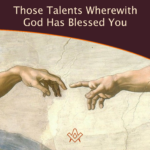 Those Talents Wherewith God Has Blessed You Incorporated in the charge to the initiate, has a lasting impression of what Freemasonry is all about. |
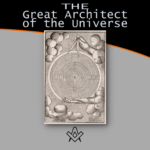 The Great Architect of the Universe When a candidate for 'Regular' Freemasonry is interviewed, prior to being admitted, he is always asked if he believes in a Supreme Being. |
masonic knowledge
to be a better citizen of the world
share the square with two brothers

click image to open email app on mobile device
